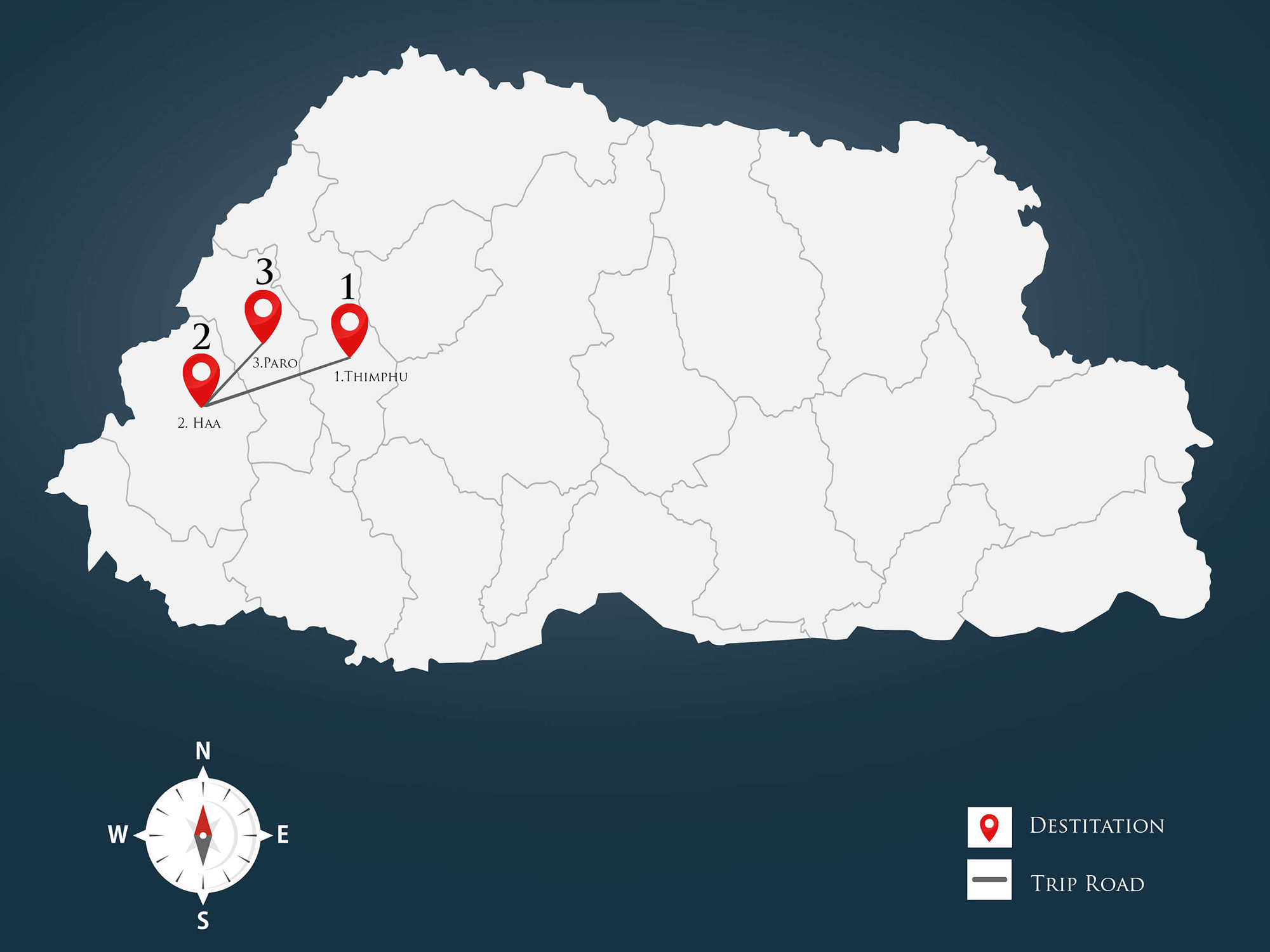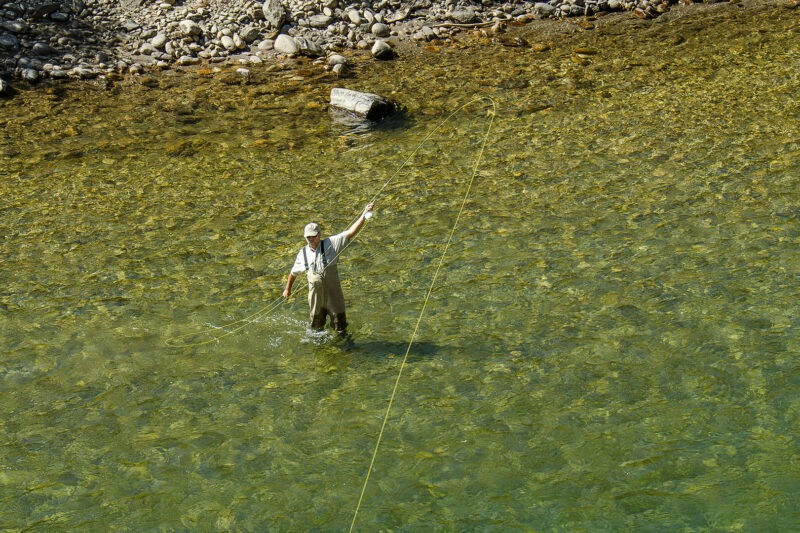Join the 7-day Bhutan fishing tour to discover one of the last undiscovered fishing destinations in the world! Enjoy a unique fishing experience in two crystal-clear rivers, Paro and Haa, and explore both the natural scenery and culture wonders in western Bhutan. This tour will also provide a travel experience through the capital of Bhutan- Thimphu, Haa and Paro valley. Highlights in this tour includes visiting the classic sights of western Bhutan, including National Memorial Chorten in Thimphu, Traditional Arts and Crafts Painting School, Traditional Paper Making Factory, Punakha Dzong and Taktshang Goemba.
Altitude in Paro: 2,280m
Onboard the aircraft, the flight is treated to spectacular views of snow peaked mountains and the Himalayan ranges. Paro airport (2,280m) is Bhutan’s only international airport where our dedicated team will receive you at the airport.
Paro Rinpung Dzong (Fortress of The Heap of Jewels)- Rinpung Dzong is an ancient fortress in traditional Bhutanese architecture with a complex of courtyards, temples, administration offices and open space surrounded by towering walls. All the buildings are equipped with huge windows with elaborate wooden carvings of traditional Bhutanese motifs. Paro Dzong is considered one of the finest examples of Bhutanese architecture and it’s one of the top tourist attractions in Bhutan. This impressive dzong is also seen during landing into Paro Airport.
National Museum of Bhutan – Ta Dzong. Originally built as a watchtower in 1649, atop a hill above the Rinpung Dzong, overlooking the whole picturesque Paro valley. Converted into a museum in 1968, its extensive collection includes astonishing antique thangka paintings, weapons and armor, and rich diversity of natural and historic artifacts.
Kyichu Lhakhang- one of the 108 temples built throughout the Himalayas by the Tibetan King Songtsen Gampo in the 7th century. The main chapel has roots as far back as the 7th century, with additional buildings and a golden roof added in 1839 by the penlop (governor) of Paro and the 25th Je Khenpo. Elderly pilgrims constantly shuffle around the temple spinning its many prayer wheels, making this one of the most charming spots in the Paro valley.
Altitude in Haa: 2,740m
Distance: 70km
Estimated travel time: 2,5hrs
Fishing along the upper Paro Chhu River.
Paro to Haa drive after lunch.
Chelela Pass- One of the highest road passes in Bhutan located between Paro valley and Haa valley. On a clear day, breathtaking views of the Himalayan peaks including Mt. Jomolhair, Mt. Jichu Drake and Mt. Kangchenjunga can been seen. In this region blue poppies (Bhutan’s national flower) also bloom during the period of late May to July.
Haa Lhakhang Karpo and Lhakhang Nagpo- Two of the 108 monasteries built by Songtsen Gampo, a Tibetan king in the 7th century. The temple is also where the guardian of the valley resides.
Altitude in Thimphu: 2,320m
Distance: 130km
Estimated travel time: 4hrs
Haa Chhu is an alpine river at an altitude of about 2700 meters. Due to this altitude, fishing in this region is advisable during late April and May or September.
The most common fish in Haa River are the brown trout and snow trout.
Haa to Thimphu drive after lunch.
Exploring the nooks and crannies of Thimphu city. Walk the streets of the capital, live the commotion, and experience the nightlife with good food and music.
Altitude in Thimphu: 2,320m
National Textile MuseumThe heritage museum replicates a rural house in the mid-19th century, using rammed mud timber, presenting objects like the leopard-skin bags and Brokpa yak-hair ‘spider’ hats. The art of Thagzo (weaving) with different styles and on a variety of materials will also be presented.
National Institute for Zorig Chusum (The Arts and Crafts School or Painting school)- The students here are enrolled in a different course that teaches the 13 traditional arts of Bhutan.
National Memorial Chorten – one of Bhutan’s most prominent buildings. The Chorten is the monument of world peace and prosperity. For Bhutanese, the site also serves as the memorial to their Third King, His Majesty Jigme Dorji Wangchuck (1928-72).
Tashicho Dzong (Fortress of The Glorious Religion)- Tashichho Dzong has been the seat of the Bhutan government since 1952. Through the years, the dzong has gone through expansions and renovation and presently houses the throne room and offices of the king, the secretariat and the ministries of home affairs and finance. Other government departments are housed in buildings nearby.
Explore and fishing in the Thimphu Chhu.
Altitude in Punakha: 1300m
Distance: 75km
Estimated travel time: 3hrs
Dochula Pass (3,050m)- Panoramic view of the Himalayan mountains. The pass is a popular location among tourists as it offers a stunning 360 degree panoramic view of the Himalayan mountain range. The view is especially scenic on clear, winter days with snowcapped mountains forming a majestic backdrop to the tranquility of the 108 chortens gracing the mountain pass.
Punakha Dzong (Palace of Great Happiness)- Built-in 1637, it is said to be the most spectacular dzong in Bhutan. Punakha Dzong was built at the confluence of two major rivers in Bhutan, the Pho Chhu and Mo Chhu, which converge in this valley.
In addition to its structural beauty, until the mid-1950s, it still served as Bhutan’s capital and the seat of the government. All of Bhutan’s kings have been crowned here, and it has witnessed the memorable wedding of the King of Bhutan, Jigme Khesar Namgyel Wangchuck to Jetsun Pema in 2011.
Chimi Lhakhang- Hike to the Temple of Fertility (altitude: 1,500m). An enjoyable hike, taking about 30 minutes through the rice and mustard fields and the uniquely decorated houses of Lobasa Village.
Overnight in Thimphu
Altitude in Paro: 2,280m
Distance: 55km
Estimated travel time: 1.30hr
Taktsang Monastery, or the Tiger’s Nest (highest altitude: 3,120m)- A 4.5 km hike that will typically take 5-6 hours ascending around 600m to reach the destination. An experience through dense enchanted forests and spectacular mountain scenery along the trail.
Kyichu Lhakhang- one of the 108 temples built throughout the Himalayas by the Tibetan King Songtsen Gampo in the 7th century. The main chapel has roots as far back as the 7th century, with additional buildings and a golden roof added in 1839 by the penlop (governor) of Paro and the 25th Je Khenpo. Elderly pilgrims constantly shuffle around the temple spinning its many prayer wheels, making this one of the most charming spots in the Paro valley.
A traditional hot stone bath at the farmhouse after all the hiking is also an option provided for relaxation.
Exploring the night life of Paro town.


